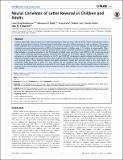Neural Correlates of Letter Reversal in Children and Adults
Author(s)
Blackburne, Liwei King; Eddy, Marianna D.; Kalra, Priya; Yee, Debbie; Sinha, Pawan; Gabrieli, John D. E.; ... Show more Show less
DownloadBlackburne-2014-Neural correlates of.pdf (2.044Mb)
PUBLISHER_CC
Publisher with Creative Commons License
Creative Commons Attribution
Terms of use
Metadata
Show full item recordAbstract
Children often make letter reversal errors when first learning to read and write, even for letters whose reversed forms do not appear in normal print. However, the brain basis of such letter reversal in children learning to read is unknown. The present study compared the neuroanatomical correlates (via functional magnetic resonance imaging) and the electrophysiological correlates (via event-related potentials or ERPs) of this phenomenon in children, ages 5–12, relative to young adults. When viewing reversed letters relative to typically oriented letters, adults exhibited widespread occipital, parietal, and temporal lobe activations, including activation in the functionally localized visual word form area (VWFA) in left occipito-temporal cortex. Adults exhibited significantly greater activation than children in all of these regions; children only exhibited such activation in a limited frontal region. Similarly, on the P1 and N170 ERP components, adults exhibited significantly greater differences between typical and reversed letters than children, who failed to exhibit significant differences between typical and reversed letters. These findings indicate that adults distinguish typical and reversed letters in the early stages of specialized brain processing of print, but that children do not recognize this distinction during the early stages of processing. Specialized brain processes responsible for early stages of letter perception that distinguish between typical and reversed letters may develop slowly and remain immature even in older children who no longer produce letter reversals in their writing.
Date issued
2014-05Department
Massachusetts Institute of Technology. Department of Brain and Cognitive Sciences; McGovern Institute for Brain Research at MITJournal
PLoS ONE
Publisher
Public Library of Science
Citation
Blackburne, Liwei King, Marianna D. Eddy, Priya Kalra, Debbie Yee, Pawan Sinha, and John D. E. Gabrieli. “Neural Correlates of Letter Reversal in Children and Adults.” Edited by Zhong-Lin Lu. PLoS ONE 9, no. 5 (May 23, 2014): e98386.
Version: Final published version
ISSN
1932-6203